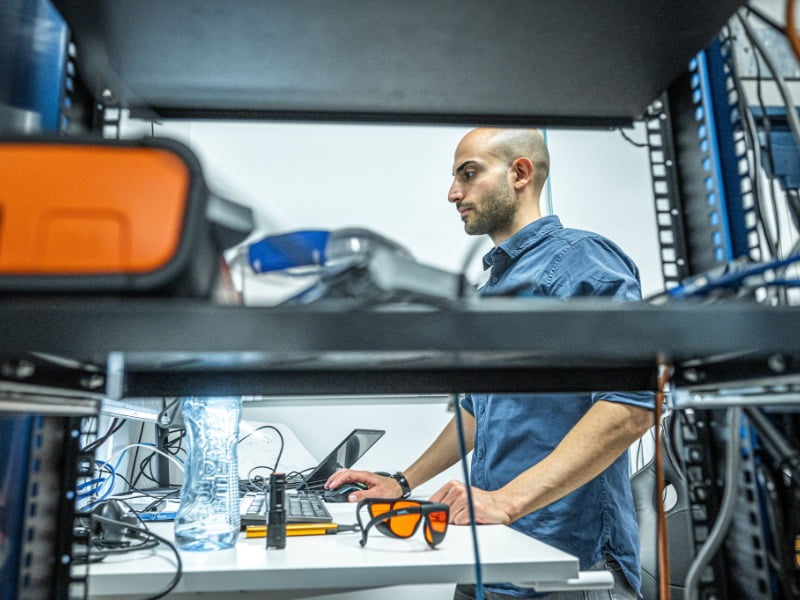Quantum Brilliance, the Australian-German deep tech startup spun-out of the Australian National University, will deliver a world first diamond quantum accelerator to the Pawsey supercomputing research facility in Perth.
The milestone comes as the Australian quantum industry seeks to convert its world leading research into commercial IP without a national quantum computing strategy.
“We have a once in a generation opportunity here to really have a national claim in what will be an incredibly important technology going for the next 50 years,” Quantum Brilliance cofounder and chief scientific officer Dr Marcus Doherty told InnovationAus.

“Australia’s got to play a strategic game here, and think about how does it develop the sovereign industry? How does it occupy strategic positions within the global supply chain, because there’s nothing holding us back except for organisation and gaining investment to really capitalise on the strength that we have here?”
“This is really big question for Australia, and it is a big opportunity.”
Quantum Brilliance was founded in 2019 with support from the ANU which then spun out the company to allow it to focus on commercialisation.
It makes lunchbox sized quantum accelerators using synthetic diamonds. The diamonds in the hardware mean quantum computing systems can be made with a much smaller physical footprint because they do not require the extreme cooling of traditional quantum computers.
The technology could mean quantum computing becomes ubiquitous, the company says, and is able to be deployed almost anywhere computers are used.
On Wednesday the company announced it would deliver the first ever diamond accelerator to the Pawsey Supercomputing Centre, a high-performance facility developed as a joint venture between the CSIRO and several Australian universities.
With the installation, Pawsey will become one of the first supercomputing centres globally to host a universal quantum computer onsite.
Quantum Brilliance is now a private Australian company. The ANU funding has ended, but the university retains a stake in the company. That early support was critical because it allowed the founders to focus on commercialising the world leading research.
“[A thing that] was critical for Quantum Brilliance to get started, was the Research School of Physics at ANU that invested strategic funds into helping the commercialisation and translation of the technology,” Dr Doherty said.
“That is really what brought things to the point where we were investor-ready, to then found the company and gain venture backing.”
Last year, Quantum Brilliance received venture funding from both institutional investors and specialty backers of cutting-edge technology, including James Krueger, an experienced Macquarie banker who now sits on the Quantum Brilliance board.
As a result, the staff count has grown from three to more than 30.
An $828,000 grant from the Department of Industry’s Entrepreneurs Programme allowed the Quantum Brilliance to build a manufacturing facility in Canberra as part of its move to commercialisation.
Quantum Brilliance founders say despite deep ties to Germany it is very much an Australian company focused on manufacturing here and helping develop the local industry.
“I think it’s very important for Australia to develop this sovereign manufacturing capability,” fellow Quantum Brilliance co-founder Mark Luo told InnovationAus.
“It’s a rare opportunity for Australia to stand out in the world with a very unique quantum architecture that is difficult for other parties to tap into. And this is the real technical moat that we’re building Australia.”
However, the industry’s growth in Australia is coming despite a lack of a national quantum computing strategy and consequently relatively low levels of investment in industry infrastructure, according to Dr Doherty.
Quantum communication networks and a national quantum computing facility are levers governments could pull to support the Australian industry and “suck in” quantum IP, he said.
“Sucking that technology in, that kickstarts those companies producing those technologies, whilst it also supports other companies who are developing software applications. [It] provides a point of focus for industry who go ‘What the hell can quantum computing do for me?’”
A national quantum computing facility would help businesses answer that question and transform their operations, supporting the emerging Australian industry, according to Dr Doherty.
For now, Quantum Brilliance considers itself a systems integrator rather than a mass manufacturer and is focused on how the company’s development kits can improve super computers and their applications.
“We’re taking the capabilities and the different electronics in order to build up the diamond quantum computing stack,” said Mr Luo. “Our strategic focus is on finding the right customers that we can learn with them together on the journey.”
So far, those customers include “the world of high performance computing”.
“They recognise that a quantum computers are going to be a thing, they’re only going to be a thing if they integrate into their existing classical computing infrastructure,” said Dr Doherty.
“And so that’s why they are very interested in working with Quantum Brilliance, both on the hardware side but also the software structures and interfaces and things that enable the system to work together.”
Quantum Brilliance is also working with the Perth based Pawsey super computing centre it delivered the first accelerator to, one of two “Tier-1” high performance computing facilities in Australia, and not dissimilar form Doherty’s proposed national facility.
The Pawsey Supercomputing Centre is an unincorporated joint venture between CSIRO, Curtin University, Edith Cowan University, Murdoch University and The University of Western Australia, with support from the Western Australian and Federal Governments.
“The Pawsey Pioneer program is really where we are getting these leading companies and researchers who are going to develop and demonstrate applications which are industry relevant,” said Dr Doherty. “And this is actually a crucial moment for a crucial step in Australians in the Australian quantum industry.”
Over the next five years Quantum Brilliance plans to mature its own technology and evolve from development kits to the commercial applications of its quantum accelerator. “That will then be the first device which can execute those applications which are developed and discovered over the next five years,” said Dr Doherty.
Do you know more? Contact James Riley via Email.

